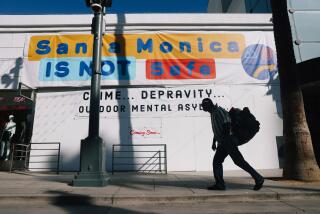Homeless Advocates Offer Plan for Shelter
- Share via
San Diego Councilman John Hartley and a newly formed group of white-collar advocates for the homeless announced Friday an eight-point plan to prepare for the yearly influx of people needing emergency shelter during the winter.
The plan, which includes resurrecting a controversial tent city on a parking lot on the fringes of Balboa Park, is scheduled to be presented Monday to the City Council.
With state budget cuts and the resulting reduction of welfare and public social services, the number of people seeking emergency housing in San Diego is expected to increase from about 7,000 to 10,000 by January, members of the advocacy group San Diegans for Shelter said Friday at a news conference in Balboa Park.
The group’s plan seeks to increase the number of beds available citywide by at least 400 before January. About 1,300 emergency beds are available in the winter.
Janay Kruger, a local developer and one of a dozen members of the advocacy group’s “Committee of 1,000” who attended the new conference, said the emergency measures being proposed are short-term solutions that the city can enact immediately with minimal expense.
The Committee of 1,000 is an outgrowth of a City Council task force on homelessness, headed by Hartley and Councilwoman Valerie Stallings.
The proposed Balboa Park tent city would accommodate about 100 people during a six-month experiment. If successful, the program would serve as a model for temporary open-air camps across the city, Kruger said.
The Balboa Park site--a 5-acre, city-owned lot leased to the Parking Co. of America--would include portable showers, latrines and fire pits for cooking. The area would be enclosed by fences and screens, and run by a city-contracted social service agency.
A similar camp in Las Vegas has been studied and could be adapted for use in San Diego, said Wayne Buss, a local architect and board member of the Centre City East Assn., a development group downtown.
Parking Co. of America owner Mark Battaglia said Friday that his company would negotiate a new lease with the city, freeing the land for the camp project.
The lot and the bordering sidewalk have been used by the homeless as an informal campground since January, said Elvin Hasty Jr., a homeless father of two whose family often parks their bronze Chevrolet panel truck in the area. The parking lot, in front of the old Balboa Navy Hospital, has not been used commercially since the facility closed in the mid-1980s.
Last month, the encampment became the site of a political tussle among the homeless, their advocates and City Hall, when activists led by Larry Milligan of Homeless American Businesses and Individuals Taking Action donated 23 tents to itinerants in the area and instructed them to pitch camp in the parking lot.
After one day, the act of defiance was quashed by police at the request of Battaglia and Mayor Maureen O’Connor. Milligan was arrested for trespassing, and the homeless were dispersed.
Many returned, and have continued to bunk down on the lot’s southern edge near Park Boulevard, overlooking Interstate 5, Hasty said.
After the disruption to daily life that the homeless group’s demonstration caused, Hasty developed a cynicism about programs purporting to serve the homeless. Upon hearing Hartley’s proposal to resurrect the tent city concept with city backing, Hasty let it be known that his disdain for City Hall runs deep.
“I don’t believe the city is going to do (expletive) for us,” Hasty said.
The plan proposed by the Committee of 1,000 tries to alleviate pressure placed on government social service agencies by encouraging business leaders and professionals to take part in programs for the homeless, Kruger said.
Homelessness has had a negative effect on businesses in areas such as Centre City East, where a disproportionate number of the city’s homeless and social service agencies have been established, Kruger said. Neighborhoods and park areas stigmatized as gathering places for the homeless have also suffered and crime has tended to increase in these areas, she said.
“What’s happening to the homeless is affecting all of us,” Kruger said. “Now is the time for business leaders to stand up and take a leadership role on these social issues.”
Components of the committee’s plan to make 400 additional beds available by January include:
* Opening a second city-run campground on a parking lot in Rose Canyon.
* Expanding the Salvation Army’s center downtown, and licensing the Neil Good Day Center for the Homeless to operate at night.
* Expanding the city’s Interfaith Network of Homeless Shelters.
* Using federal emergency housing money to pay for vouchers at low-cost hotels.
Elvin Hasty had his own suggestion: Patience.
“You can’t expect to jump right in and have everything go smooth right off the bat,” he said. “You got to give homeless people the time to weed out our own problems. A good community will do that.”
More to Read
Sign up for Essential California
The most important California stories and recommendations in your inbox every morning.
You may occasionally receive promotional content from the Los Angeles Times.










